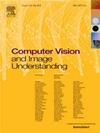A vector quantized masked autoencoder for audiovisual speech emotion recognition
IF 4.3
3区 计算机科学
Q2 COMPUTER SCIENCE, ARTIFICIAL INTELLIGENCE
引用次数: 0
Abstract
An important challenge in emotion recognition is to develop methods that can leverage unlabeled training data. In this paper, we propose the VQ-MAE-AV model, a self-supervised multimodal model that leverages masked autoencoders to learn representations of audiovisual speech without labels. The model includes vector quantized variational autoencoders that compress raw audio and visual speech data into discrete tokens. The audiovisual speech tokens are used to train a multimodal masked autoencoder that consists of an encoder–decoder architecture with attention mechanisms. The model is designed to extract both local (i.e., at the frame level) and global (i.e., at the sequence level) representations of audiovisual speech. During self-supervised pre-training, the VQ-MAE-AV model is trained on a large-scale unlabeled dataset of audiovisual speech, for the task of reconstructing randomly masked audiovisual speech tokens and with a contrastive learning strategy. During this pre-training, the encoder learns to extract a representation of audiovisual speech that can be subsequently leveraged for emotion recognition. During the supervised fine-tuning stage, a small classification model is trained on top of the VQ-MAE-AV encoder for an emotion recognition task. The proposed approach achieves state-of-the-art emotion recognition results across several datasets in both controlled and in-the-wild conditions.

一种用于视听语音情感识别的矢量量化掩码自编码器
情感识别的一个重要挑战是开发能够利用未标记训练数据的方法。在本文中,我们提出了VQ-MAE-AV模型,这是一个自监督的多模态模型,它利用掩码自编码器来学习无标签的视听语音表示。该模型包括矢量量化变分自编码器,将原始音频和视觉语音数据压缩成离散的符号。利用这些视听语音标记来训练一个多模态掩码自编码器,该自编码器由具有注意机制的编码器-解码器结构组成。该模型旨在提取视听语音的局部(即帧级)和全局(即序列级)表示。在自监督预训练中,VQ-MAE-AV模型在大规模未标记的视听语音数据集上进行训练,以重建随机掩码的视听语音标记,并采用对比学习策略。在这个预训练期间,编码器学习提取视听语音的表示,随后可以用于情感识别。在监督微调阶段,在VQ-MAE-AV编码器上训练一个小型分类模型,用于情绪识别任务。所提出的方法在受控和野外条件下实现了跨多个数据集的最先进的情感识别结果。
本文章由计算机程序翻译,如有差异,请以英文原文为准。
求助全文
约1分钟内获得全文
求助全文
来源期刊

Computer Vision and Image Understanding
工程技术-工程:电子与电气
CiteScore
7.80
自引率
4.40%
发文量
112
审稿时长
79 days
期刊介绍:
The central focus of this journal is the computer analysis of pictorial information. Computer Vision and Image Understanding publishes papers covering all aspects of image analysis from the low-level, iconic processes of early vision to the high-level, symbolic processes of recognition and interpretation. A wide range of topics in the image understanding area is covered, including papers offering insights that differ from predominant views.
Research Areas Include:
• Theory
• Early vision
• Data structures and representations
• Shape
• Range
• Motion
• Matching and recognition
• Architecture and languages
• Vision systems
 求助内容:
求助内容: 应助结果提醒方式:
应助结果提醒方式:


